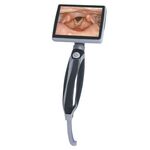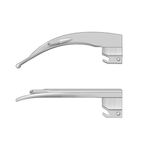Laryngoscope
A laryngoscope is medical equipment used to view the larynx (voice box) and surrounding areas, often for diagnostic or surgical purposes. It is essential in fields like anesthesiology, otolaryngology, and emergency medicine.
What is a Laryngoscope?
A laryngoscope is used to examine the vocal cords, detect abnormalities in the throat, and assist in procedures like intubation. A laryngoscope typically consists of a handle, a light source, and a blade. The blade may be curved or straight based on its intended use. They come with various blade types for specific applications. The curved blade is better for viewing vocal cords indirectly, while the straight blade is ideal for lifting the epiglottis directly. Modern laryngoscopes often have LED lights for better visibility and video cameras for recording and live monitoring of procedures. A laryngoscope can be either disposable to ensure sterility or reusable, designed to withstand repeated sterilization processes.
What is the use of Laryngoscope?
The primary function of a laryngoscope is to visualize the larynx (voice box) and surrounding structures for medical examination or intervention. Below are its key functions:
A laryngoscope is used to inspect the throat, vocal cords, and larynx to identify abnormalities like swelling, tumors, or infections. It is crucial for placing an endotracheal tube into the trachea during anesthesia or emergency situations, ensuring a clear airway. Surgeons use a laryngoscope during procedures involving the throat, vocal cords, or nearby tissues to improve visibility and precision. A laryngoscope helps diagnose conditions affecting voice production by providing a clear view of the vocal cords in action.
How does the work laryngoscope?
A laryngoscope works by providing a clear view of the larynx and surrounding structures through direct or indirect visualization, aiding in diagnostic or procedural tasks.
Here's how a laryngoscope works step-by-step:
The laryngoscope is equipped with a light source (usually LED or fiber-optic), which illuminates the throat, enabling clear visibility of the airway structures. The clinician inserts the laryngoscope blade into the patient's mouth, carefully maneuvering to avoid discomfort or injury. The laryngoscope blade is positioned to lift the tongue and epiglottis, revealing the vocal cords and the larynx. This step varies depending on the blade type. The laryngoscope provides a stable pathway for procedures like endotracheal intubation, where a breathing tube is guided into the trachea. In video laryngoscopes, a camera on the blade transmits a live feed to a screen, offering better visualization for complex cases or training purposes. Once the examination or procedure is complete, the laryngoscope is carefully removed to avoid injuring the patient’s mouth or throat.
What are the features of a laryngoscope?
It comes with various features that enhance its functionality and usability in different medical scenarios.
Here are the main features of a laryngoscope:
Light Source: Every laryngoscope has a built-in light, such as LED or fiber-optic illumination, to brighten the airway and improve visibility during procedures.
Interchangeable Blades: A laryngoscope offers different blade types, such as curved (Macintosh) or straight, to suit various medical needs and patient anatomies.
Video Camera Option: Advanced laryngoscopes come with video cameras that display real-time images on a screen, making it easier to navigate and perform complex tasks.
Portable and Lightweight: A laryngoscope is usually compact and lightweight, making it convenient for doctors to carry and use in different clinical settings.
Reusable and Disposable blade Options: Depending on the requirement, a laryngoscope blades can be reusable (with sterilization) or disposable for single-use to maintain sterility.
Battery-Powered Operation: Most laryngoscopes are battery-operated, ensuring consistent light and performance during medical emergencies or surgeries.
Overview of Laryngoscope Price:
Laryngoscope price starts from INR 4000 to INR 245,000 depending on types, brands, blade type & size. Here below, we have mentioned the price.
| S. No. | LARYNGOSCOPE PRODUCT MODEL | PRICE (INR) |
| 1. | Scope Medical Conventional Laryngoscope | INR 75,00 |
| 2. | Welch Allyn Miller Laryngoscope, Fiber Optic Set | INR 64,900 |
| 3. | Heine Flextip+ Fiber Optic Laryngoscope | INR 84,000 |
| 4. | Pediatric LARYNGOSCOPE FIBER OPTIC | INR 15,100 |
| 5. | Hugemed Portable Video laryngoscope | INR 96,800 |
| 6. | Medtronic McGRATH MAC Video Laryngoscope | INR 141,200 |
| 7. | BPL Video Laryngoscope | INR 109,000 |
| 8. | Ambu King Vision Video Laryngoscope | INR 112,000 |
*Price may be subject to change.
Different Types of Laryngoscope:
There are several types of laryngoscopes designed to meet specific medical needs, each tailored to unique patient groups or procedures. Below are the key types of laryngoscopes:
1. Paediatric Laryngoscope
A paediatric laryngoscope is specially designed for infants and children, featuring smaller blades and handles for their delicate anatomy. These laryngoscopes ensure safe airway management in younger patients and are often used during intubation or examinations in pediatric care.
2. Video Laryngoscope
A video laryngoscope incorporates a camera and screen for enhanced visualization of the airway. It provides a clearer view of the larynx and vocal cords, improving precision in difficult intubations and making it invaluable in modern medical settings.
3. Fibre Optic Laryngoscope
A fibre optic laryngoscope uses fiber-optic technology to deliver light directly to the airway, offering excellent illumination even in challenging environments. These laryngoscopes are often preferred for their flexibility and ability to provide indirect views in complex cases.
Best Brands of Laryngoscope:
Some of the best laryngoscope brands known for their quality and reliability are:
1. Welch Allyn:
Welch Allyn offers high-quality laryngoscopes with advanced features like fiber-optic illumination and durable materials. Their products are widely used in hospitals and clinics for their reliability and ergonomic design.
2. BPL:
BPL provides cost-effective laryngoscopes with excellent performance. Their models are known for being lightweight, easy to handle, and ideal for general medical use.
3. Medtronic:
Medtronic is offering laryngoscopes with cutting-edge technology, including video-enabled options. Their products cater to both standard and complex airway management needs.
Things to be considered before buying a Laryngoscope:
Before buying a laryngoscope, it’s essential to consider key factors to ensure it suits your specific medical needs. From the type of blade to advanced features, the right choice will enhance efficiency and patient safety.
1. Type of Laryngoscope
2. Blade Options
3. Light Source
4. Material and Durability
5. Ease of Sterilization
6. Video or Traditional
7. Cost and Budget
8. Disposable vs. Reusable
Why Should you buy Laryngoscope From Biomed Suppliers:
Buying a laryngoscope from Biomed Suppliers, ensures convenience, quality, and value for your purchase.
Here's why you should consider it:
1. Wide Variety of Laryngoscope Options: Biomed Suppliers offers a diverse range of laryngoscopes, including video, fiber-optic, and pediatric types, from leading brands like Welch Allyn, BPL, Medtronic, and Ambu.
2. Competitive Pricing: At Biomed Suppliers, you can find laryngoscopes at competitive prices, with options to suit various budgets without compromising quality.
3. Authentic and Certified Products: All laryngoscopes sold on Biomed Suppliers are 100% authentic and come with necessary certifications, ensuring safety and reliability for medical use.
4. Easy Online Shopping: The platform provides a user-friendly interface for browsing and purchasing laryngoscopes, saving time compared to traditional shopping methods.
5. Expert Assistance: Biomed Suppliers has customer support teams to assist you in selecting the right laryngoscope based on your specific requirements.
FAQs:
1. What is a laryngoscope used for?
A laryngoscope is used to examine the larynx (voice box) and vocal cords. It also helps during procedures like intubation to secure an airway.
2. What are the types of laryngoscopes?
The main types include pediatric laryngoscopes (for children), video laryngoscopes (with a camera for enhanced visualization), and fiber-optic laryngoscopes (for clear, illuminated views).
3. What is the difference between a curved and straight blade laryngoscope?
A curved blade (Macintosh) lifts the epiglottis indirectly, while a straight blade (Miller) lifts it directly. The choice depends on patient anatomy and medical requirements.
4. How do you sterilize a reusable laryngoscope?
Reusable laryngoscopes should be cleaned thoroughly with disinfectant and sterilized using an autoclave or high-level chemical solution, as recommended by the manufacturer.
5. Are there disposable laryngoscopes available?
Yes, disposable laryngoscopes are available for single use to ensure sterility and prevent cross-contamination.
6. What are video laryngoscopes?
Video laryngoscopes have a built-in camera and screen, providing a live view of the airway. They are particularly useful for difficult intubation and training.
7. Which is the best brand of laryngoscope?
Some of the best brands include Welch Allyn, BPL, Medtronic, and Ambu, known for their quality and advanced features.
8. How much does a laryngoscope cost?
The price of a laryngoscope varies based on the type, brand, and features. Laryngoscope price starts from INR 4000 to INR 245,000.
9. Can a laryngoscope be used for pediatric patients?
Yes, pediatric laryngoscopes are specifically designed for infants and children, featuring smaller blades and handles.
10. Where can you buy a laryngoscope?
You can buy a laryngoscope from Biomed Suppliers, which offers a wide range of options from top brands.



